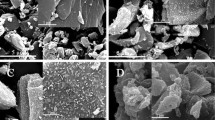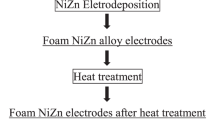Abstract
In this paper, a novel electrically conductive alumina/nano-carbon network (NCN) composite material was used as an electrocatalyst carrier. A NiCu/Al2O3/NCN composite electrode was prepared by electrodepositing NiCu particles onto the surface of the conductive alumina/NCN composite. Morphology, composition, crystalline structure and electrochemical properties of the NiCu/Al2O3/NCN composite electrode were investigated. The results showed that NiCu particles can be deposited onto the surface of the alumina/NCN composite by a coelectrodeposition method. NiCu particles in the form of solid solution with face-centered cubic (fcc) structure were relatively uniformly distributed over the carbon layer of the conductive ceramic between alumina grains. As-resulted NiCu/Al2O3/NCN composite electrode had a remarkably enhanced electrochemical activity and high stabilization for oxygen evolution reaction, which indicated its potential application with enhanced performance to oxygen evolution reaction (OER). Moreover, based on the electrochemical measurement, the mechanism of the OER on the NiCu/Al2O3/NCN composite electrode was discussed.
Similar content being viewed by others
References
Chi B, Li J, Yang X, et al. Deposition of Ni-Co by cyclic voltammetry method and its electrocatalytic properties for oxygen evolution reaction. Int J Hydrogen Energ, 2005, 30: 29–34
Restovic A, Poillerat G, Chartier P, et al. Oxygen evolution reaction on copper manganites-effect of preparation method and electrode manufacturing on superficial sites density. Electrochim Acta, 1994, 39: 1579–1584
Wu Y N, Liao S J, Wang K, et al. High pressure organic colloid method for the preparation of high performance carbon nanotube-supported Pt and PtRu catalysts for fuel cell applications. Sci China Tech Sci, 2010, 53: 264–271
Ye Z, Meng H, Sun D. Electrochemical impedance spectroscopic (EIS) investigation of the oxygen evolution reaction mechanism of Ti/IrO2+MnO2 electrodes in 0.5 m H2SO4 solution. J Electroanal Chem, 2008, 621: 49–54
Kubisztal J, Budniok A. Study of the oxygen evolution reaction on nickel-based composite coatings in alkaline media. Int J Hydrogen Energ, 2008, 33: 4488–4494
Mohammad A M, Awad M I, El-Deab M S, et al. Electrocatalysis by nanoparticles: Optimization of the loading level and operating pH for the oxygen evolution at crystallographically oriented manganese oxide nanorods modified electrodes. Electrochim Acta, 2008, 53: 4351–4358
Li W S, Chen H Y, Long X M, et al. Oxygen evolution reaction on lead-bismuth alloys in sulfuric acid solution. J Power Sources, 2006, 158: 902–907
Matsumoto Y, Sato E. Electrocatalytic properties of transition metal oxides for oxygen evolution reaction. Mater Chem Phys, 1986, 14: 397–426
Fazle Kibria A K M, Tarafdar S A. Electrochemical studies of a nickel-copper electrode for the oxygen evolution reaction (OER). Int J Hydrogen Energ, 2002, 27: 879–884
Nikolov I, Darkoui R, Zhecheva E, et al. Electrocatalytic activity of spinel related cobalties MxCo3−x O4 (M = Li, Ni, Cu) in the oxygen evolution reaction. J Electroanal Chem, 1997, 429: 157–168
Kibria M F, Mridha M S H. Electrochemical studies of the nickel electrode for the oxygen evolution reaction. Int J Hydrogen Energ, 1996, 21: 179–182
Pham M T, Maitz M F, Richter E, et al. Electrochemical behaviour of nickel surface-alloyed with copper and titanium. J Electroanal Chem, 2004, 572: 185–193
Chen G Y, Bare S R, Mallouk T E. Development of supported bifunctional electrocatalysts for unitized regenerative fuel cells. J Electrochem Soc, 2002, 149: A1092–A1099
Ma L, Sui S, Zhai Y. Preparation and characterization of Ir/TiC catalyst for oxygen evolution. J Power Sources, 2008, 177: 470–477
Bursell M, Pirjamali M, Kiros Y. La0.6Ca0.4CoO3, La0.1Ca0.9MnO3 and LaNiO3 as bifunctional oxygen electrodes. Electrochim Acta, 2002, 47: 1651–1660
Xu B S, Yang X W, Wang X M, et al. A novel catalyst support for DMFC: Onion-like fullerenes. J Power Sources, 2006, 162: 160–164
Menchavez R L, Fuji M, Takahashi M. Electrically conductive dense and porous alumina with in-situ-synthesized nanoscale carbon. Adv Mater, 2008, 20: 2345–2351
Menchavez R L, Fuji M, Takahashi M. Electrical conductivity of gelcast alumina sintered under inert atmosphere. J Eur Ceram Soc, 2009, 29: 949–954
Hai C, Liu J, Watanabe H, et al. Surface activation of conductive porous alumina by depositing nickel particles. J Am Ceram Soc, 2009, 92: s38–s41
Guha A, Lu W, Zawodzinski Jr T A, et al. Surface-modified carbons as platinum catalyst support for PEM fuel cells. Carbon, 2007, 45: 1506–1517
Bittencourt C, Felten A, Ghijsen J, et al. Decorating carbon nanotubes with nickel nanoparticles. Chem Phys Lett, 2007, 436: 368–372
Liu J, Menchavez R L, Watanabe H, et al. Highly conductive alumina/ NCN composites electrodes fabricated by gelcasting and reduction-sintering-An electrochemical behavior study in aggressive environments. Electrochim Acta, 2008, 53: 7191–7197
Liu J, Watanabe H, Fuji M, et al. Electrocatalytic evolution of hydrogen on porous alumina/gelcast-derived nano-carbon network composite electrode. Electrochem Comm, 2009, 11: 107–110
Alper M, Kockar H, Safak M, et al. Comparison of Ni-Cu alloy films electrodeposited at low and high pH levels. J Alloy Compd, 2008, 453: 15–19
Danaee I, Jafarian M, Forouzandeh F, et al. Electrocatalytic oxidation of methanol on Ni and NiCu alloy modified glassy carbon electrode. Int J Hydrogen Energ, 2008, 33: 4367–4376
Kumar K S, Haridoss P, Seshadri S K. Synthesis and characterization of electrodeposited Ni-Pd alloy electrodes for methanol oxidation. Surf Coat Tech, 2008, 202(9): 1764–1770
Yeo I H, Johnson D C. Electrochemical response of small organic molecules at nickel-copper alloy electrodes. J Electroanal Chem, 2001, 495: 110–119
Casella I G, Gatta M. Electrodeposition and characterization of nickel-copper alloy films as electrode material in alkaline media. J Electrochem Soc, 2002, 149: B465–B471
Druska P, Strehblow H H, Golledge S. A surface analytical examination of passive layers on Cu/Ni alloys: Part I. Alkaline solution. Corros Sci, 1996, 38: 835–51
Luo P, Prabhu S V, Baldwin R P. Constant potential amperometric detection at a copper-based electrode: Electrode formation and operation. Anal Chem, 1990, 62: 752–755
Le W Z, Liu Y Q. Preparation of nano-copper oxide modified glassy carbon electrode by a novel film plating/potential cycling method and its characterization. Sensor Actuat B-Chem, 2009, 141: 147–153
Heli H, Jafarian M, Mahjani M G, et al. Electro-oxidation of methanol on copper in alkaline solution. Electrochim Acta, 2004, 49: 4999–5006
Sato N, Okamoto G. Reaction mechanism of anodic oxygen evolution on nickel in sulphate solutions. Electrochim Acta, 1965, 10: 495–502
Author information
Authors and Affiliations
Corresponding author
Rights and permissions
About this article
Cite this article
Zhao, X., Fuji, M., Shirai, T. et al. Electrocatalytic evolution of oxygen on NiCu particles modifying conductive alumina/nano-carbon network composite electrode. Sci. China Technol. Sci. 55, 3388–3394 (2012). https://doi.org/10.1007/s11431-012-4992-5
Received:
Accepted:
Published:
Issue Date:
DOI: https://doi.org/10.1007/s11431-012-4992-5




